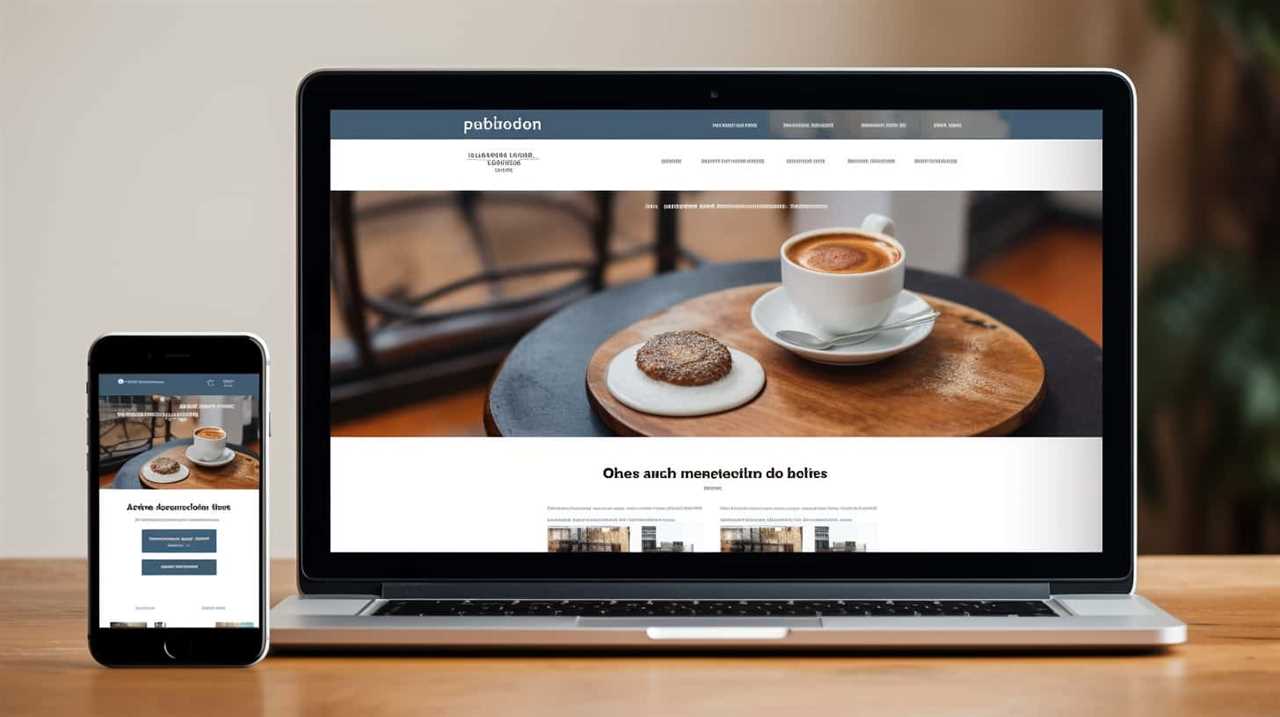Everyone has experienced the frustration of searching for relevant information online, only to be bombarded with irrelevant content.
That’s why we’re here to tell you about the power of topical authority content in enhancing user experience.
By providing valuable and up-to-date information tailored to user intent, we can create engaging content that is both readable and accessible.
With our user-focused approach, we aim to build trust, credibility, and ultimately, deliver the liberating experience users deserve.

Key Takeaways
- Topical authority content can enhance user experience by establishing expertise and credibility in a specific industry or subject area.
- Creating engaging content through visual storytelling and interactive elements can capture user attention and increase engagement and retention.
- Personalizing content based on user demographics and browsing patterns can optimize the user experience and increase engagement.
- Utilizing data analysis to measure performance metrics and identify relevant topics and keywords can ensure that content remains current, informative, and valuable to users.
Understanding User Experience (UX)
As we delve into enhancing user experience with topical authority content, it’s essential to understand the importance of user experience (UX) in driving engagement and satisfaction.
Understanding user behavior and designing with a user-centric approach are key elements in creating a successful digital experience. User behavior refers to how individuals interact with a website, app, or other digital platforms. By studying user behavior, we gain insights into their preferences, needs, and motivations. This knowledge allows us to design with empathy, anticipating their actions and providing a seamless and intuitive experience.
User-centric design puts the user at the center of the creative process, ensuring that every decision is made with their best interests in mind. It prioritizes usability, accessibility, and overall user satisfaction. By adopting a user-centric design approach, we can create experiences that empower, liberate, and delight our audience.
Importance of Content Relevance
To further enhance user experience, we frequently prioritize content relevance, ensuring that the information provided aligns with the interests and needs of our users. Content personalization plays a crucial role in achieving this goal.

By analyzing our target audience, we gain valuable insights into their preferences, demographics, and behaviors. This allows us to create tailored content that resonates with them on a deeper level. We understand that our users desire liberation and crave content that truly speaks to them.
By personalizing our content, we can deliver a more meaningful and engaging experience. Through target audience analysis, we uncover the topics that matter most to our users, enabling us to provide relevant and valuable information that meets their specific needs.
This level of personalization not only enhances user experience but also fosters a sense of trust and loyalty.
The Power of Topical Authority
We frequently leverage topical authority to enhance user experience.

By establishing ourselves as experts in our industry, we can have a powerful impact on our audience and gain industry recognition.
Topical authority refers to our deep knowledge and expertise in a particular subject matter.
When we consistently produce high-quality content and provide valuable insights, our audience sees us as a trusted source of information.
This builds credibility and establishes us as thought leaders in our field.

As a result, our audience is more likely to engage with our content, share it with others, and seek our expertise.
This recognition not only enhances user experience but also helps us create engaging content that resonates with our audience’s needs and interests.
Now, let’s dive into the next section and explore strategies for creating engaging content.
Creating Engaging Content
When it comes to creating engaging content, two powerful techniques that can capture the attention of users are visual storytelling and interactive multimedia elements.

Visual storytelling allows us to convey information in a compelling and immersive way, using images, videos, and graphics to tell a story that resonates with our audience.
By incorporating interactive multimedia elements, such as quizzes, polls, and interactive infographics, we can further enhance user engagement and create a more interactive and enjoyable experience.
These techniques not only make our content more engaging, but also help to keep users on our website longer, increasing the chances of them becoming loyal and returning visitors.
Visual Storytelling Techniques
One key technique for creating engaging content is incorporating a variety of visual storytelling methods. By using visuals, we can capture the attention of our audience and deliver our message in a more compelling and memorable way.

Here are three storytelling techniques that can help improve engagement:
- Infographics: Utilizing graphics, charts, and icons to present information in a visually appealing and easily digestible format.
- Videos: Creating dynamic videos that combine visuals, sound, and storytelling to convey complex ideas or emotions.
- Interactive images: Incorporating interactive elements such as hotspots or sliders to allow users to explore and engage with the content actively.
By incorporating these storytelling techniques into our content, we can’t only grab the attention of our audience but also provide a more immersive and interactive experience.
Now, let’s move on to the next section where we’ll discuss the importance of incorporating interactive multimedia elements.
Interactive Multimedia Elements
To further enhance the user experience and create engaging content, incorporating interactive multimedia elements is essential.

Interactive video elements are a powerful tool that can captivate and immerse users, increasing their level of engagement. By allowing users to actively participate in the content, interactive videos provide a unique and personalized experience.
They can include features such as clickable hotspots, quizzes, and interactive menus, enabling users to interact with the video and make choices that shape the narrative. This interactivity not only keeps users engaged but also allows them to feel a sense of control and involvement in the content.
By integrating interactive multimedia elements into your content strategy, you can create a dynamic and immersive user experience that leaves a lasting impression.
Now, let’s explore how tailoring content to user intent can further enhance the overall user experience.

Tailoring Content to User Intent
We optimize our content to align with user intent, ensuring a tailored and personalized experience. Understanding user behavior and tailoring content to user preferences is crucial in enhancing user engagement and satisfaction. Here are three ways we achieve this:
- Conducting thorough research: We delve into user demographics, interests, and motivations to gain insights into what they want and need. This helps us create content that resonates with their preferences and addresses their pain points.
- Analyzing user data: We use analytics tools to track user behavior on our website, such as click-through rates, time spent on page, and bounce rates. This data provides valuable insights into user intent, allowing us to optimize our content accordingly.
- Implementing user feedback: We actively listen to our users through surveys, comments, and social media interactions. By taking their feedback into account, we can tailor our content to better meet their expectations and deliver a more satisfying user experience.
Consistency in Content Delivery
To ensure an optimal user experience, maintaining a consistent delivery of content is essential. Users rely on consistency to build trust and familiarity with a website or platform. By consistently delivering content that meets their expectations, we can enhance their overall experience and keep them engaged.
One way to achieve consistency is by maintaining content freshness. This means regularly updating and refreshing the information on our website to ensure it remains relevant and up to date. By doing so, we can provide users with accurate and timely information, keeping them informed and satisfied.
Another aspect of content consistency is ensuring a cohesive and unified voice throughout all our content pieces. This includes using consistent language, tone, and style across different platforms and channels. By doing so, we can create a seamless and cohesive user experience, making it easier for users to navigate and engage with our content.

Incorporating a table can further enhance the user’s understanding of the importance of content consistency. Here is an example:
| Maintaining Content Freshness | Ensuring Content Consistency |
|---|---|
| Regularly updating and refreshing information | Using consistent language, tone, and style |
| Providing accurate and timely information | Creating a seamless and cohesive user experience |
| Keeping users informed and satisfied | Enhancing user trust and familiarity |
| Increasing engagement and retention | Improving navigation and usability |
| Staying relevant in an ever-changing landscape | Building a strong brand identity |
Utilizing Data for Content Optimization
By analyzing data, we can optimize content to enhance the user experience. Data analysis provides valuable insights into user behavior, preferences, and needs, allowing us to tailor our content accordingly.
Here are three ways we can utilize data for content optimization:
- Personalization: By understanding user demographics and browsing patterns, we can create personalized content that resonates with individual users, increasing engagement and satisfaction.
- Performance measurement: By tracking metrics such as click-through rates, bounce rates, and time spent on page, we can identify which content performs best and make informed decisions about what to prioritize and improve.
- Content relevance: Through data analysis, we can identify the topics and keywords that are most relevant to our target audience, ensuring our content remains current, informative, and valuable.
Incorporating Multimedia Elements
When it comes to enhancing user experience, incorporating multimedia elements can have a significant impact.

Visual content, such as images, videos, and infographics, can capture the attention of users and make the content more engaging.
Visual Impact on UX
We can enhance the user experience by incorporating multimedia elements that create a visually impactful interface. Visual design plays a crucial role in engaging users and capturing their attention.
Here are three ways in which visual impact can improve user experience:
- Attractiveness: Eye-catching visuals, such as high-quality images or videos, can instantly grab users’ attention and make them more likely to engage with the content.
- Clarity: Clear and well-designed visuals can effectively communicate information, making it easier for users to understand and navigate through the interface.
- Emotional connection: Visual elements can evoke emotions and create a more immersive experience for users. By using compelling visuals that resonate with the target audience, we can establish a deeper connection and enhance the overall user experience.
By incorporating these visual elements, we can ensure that users have an engaging and enjoyable experience while interacting with the content.

Now let’s explore how to further engage with multimedia elements.
Engaging With Multimedia
To further enhance the user experience, let’s delve into how we can effectively engage with multimedia elements by incorporating them into our content. One powerful way to engage users is through engaging videos. Videos capture attention and allow users to visually connect with the content. By incorporating relevant and informative videos into our articles, we can provide a more immersive experience that keeps users engaged and wanting more.
Another effective strategy is to incorporate interactive quizzes. Quizzes not only provide users with a fun and interactive experience, but they also encourage active participation and knowledge retention. By incorporating quizzes that align with the topic at hand, we can create an engaging and educational experience for our users.
By incorporating engaging videos and interactive quizzes into our content, we can create a more dynamic and interactive user experience. This not only keeps users on our site longer but also encourages them to explore more of our content, ultimately increasing our topical authority.

Now that we understand how to engage with multimedia elements, let’s move on to the next step: evaluating user feedback.
Evaluating User Feedback
The evaluation of user feedback is an essential step in enhancing the user experience with topical authority content. By evaluating user satisfaction and analyzing user feedback, we can gain valuable insights and make improvements that align with our audience’s needs and desires. Here are three key reasons why evaluating user feedback is crucial:
- Identifying pain points: User feedback allows us to identify any pain points or frustrations that users may be experiencing. By understanding these challenges, we can address them and provide a smoother, more enjoyable user experience.
- Improving content relevance: User feedback helps us gauge the relevance and effectiveness of our content. It allows us to understand what topics resonate with our audience and make adjustments accordingly, ensuring that our content remains valuable and authoritative.
- Building trust and loyalty: By actively listening to our users and incorporating their feedback, we show that we value their opinions and are committed to delivering a user-focused experience. This builds trust and loyalty, encouraging users to return and engage with our content on a regular basis.
Evaluating user feedback is an ongoing process that allows us to continuously improve our topical authority content and provide a truly exceptional user experience.
Enhancing Readability and Accessibility
Improving readability and accessibility through the use of clear and concise language is a key aspect of enhancing the user experience with topical authority content. When creating content, it is important to consider the diverse range of users who will be accessing it. By focusing on improving legibility and enhancing inclusivity, we can ensure that our content is accessible to all users, regardless of their abilities or backgrounds.

One way to achieve this is by using a straightforward writing style that avoids complex jargon and technical terms. This helps to make the content easier to understand for a wider audience. Additionally, using headings, subheadings, and bullet points can help to break up the text and make it more scannable.
To emphasize the importance of enhancing readability and accessibility, we have created a table that highlights the benefits of this approach:
| Benefits of Improving Readability and Accessibility |
|---|
| 1. Increases user engagement |
| 2. Improves comprehension and retention of information |
| 3. Enhances inclusivity and reaches a wider audience |
Keeping Content Up-to-Date
How do we ensure that our topical authority content remains relevant and valuable over time? By updating content regularly, we can maximize its SEO potential and keep it up-to-date. Here are three ways to achieve this:
- Conduct regular content audits:
Regularly review your content to identify outdated information or broken links. This will help you identify areas that need updating and ensure that your content remains accurate and reliable. - Stay informed about industry trends:
Keep up with the latest developments in your industry and update your content accordingly. This will help you provide the most current and valuable information to your audience. - Engage with user feedback:
Pay attention to user comments, questions, and suggestions. Use this feedback to update your content, address any gaps or concerns, and provide a better user experience.
By consistently updating your content, you can maintain its relevance and value, enhancing your authority and building trust with your audience.

Next, let’s explore how to build trust and credibility through our content.
Building Trust and Credibility
When it comes to building trust and credibility with our audience, expertise is key. We want our users to see us as reliable sources of information in our field.
Expertise for Credibility
To establish credibility and build trust, we focus on demonstrating our expertise through topical authority content. This allows us to validate our expertise and gain recognition within our industry.
Here are three ways we achieve this:

- Consistent and high-quality content: By consistently producing well-researched and insightful content, we showcase our knowledge and expertise in the field. This helps to establish us as a credible source of information.
- Expert contributions and collaborations: We actively seek opportunities to contribute our expertise to industry publications, conferences, and events. By sharing our knowledge with others, we gain recognition and validation from our peers.
- Client testimonials and case studies: We showcase our expertise by sharing success stories and testimonials from satisfied clients. This provides tangible evidence of our capabilities and builds trust with potential clients.
Engaging and Reliable Content
We actively strive to create engaging and reliable content that builds trust and credibility by consistently delivering valuable information to our audience. We understand that user engagement is key to establishing a strong connection with our readers and keeping them coming back for more. By crafting content that isn’t only informative but also interesting and interactive, we aim to captivate our audience and create a sense of involvement.
We believe that content reliability is crucial in building trust, which is why we prioritize thorough research and fact-checking to ensure that our information is accurate and up-to-date. We want our audience to rely on us as a reliable source of information they can trust.
By focusing on user engagement and content reliability, we’re confident in our ability to build trust and credibility with our audience.
Now that we’ve discussed the importance of engaging and reliable content, let’s move on to the next section where we’ll explore the methods for measuring success and ROI.

Measuring Success and ROI
In order to accurately assess the success and ROI of topical authority content, it’s essential for marketers to employ comprehensive tracking and analytics tools. By measuring effectiveness and return on investment (ROI), marketers can gain valuable insights into the performance of their content and make data-driven decisions to optimize their strategies.
Here are three key ways to measure success and ROI:
- Track website traffic: Utilize analytics tools to monitor the number of visitors, page views, and time spent on your website. This data can help you understand how well your topical authority content is attracting and engaging users.
- Monitor conversions: Measure the number of conversions, such as sign-ups, downloads, or purchases, that result from your content. This metric directly reflects the effectiveness of your content in driving desired actions.
- Analyze social engagement: Examine the number of likes, shares, comments, and mentions your content receives on social media platforms. This indicates the level of audience engagement and the potential reach of your content.
Frequently Asked Questions
How Can User Feedback Be Effectively Collected and Analyzed to Enhance the User Experience?
We collect and analyze user feedback to enhance the user experience. By listening and understanding their needs, we can make informed decisions and create a more engaging and satisfying experience for all.
What Are Some Techniques for Incorporating Multimedia Elements Into Content to Make It More Engaging?
Incorporating interactive elements and storytelling techniques can make content more engaging. It allows us to captivate our audience and create a user experience that is both informative and enjoyable.

How Can Content Creators Tailor Their Content to Match the User’s Intent and Deliver a Personalized Experience?
To enhance user experience, we tailor our content by understanding user intent and employing personalization techniques. By doing so, we deliver a personalized experience that engages users, making them feel liberated and valued.
What Are the Best Practices for Keeping Content Up-To-Date and Ensuring Its Accuracy Over Time?
To keep content up-to-date and accurate over time, we employ various best practices and strategies. By regularly reviewing and updating information, conducting thorough research, and citing authoritative sources, we ensure our content remains reliable and valuable for our users.
How Can Content Creators Build Trust and Credibility With Their Audience Through Their Content?
Building rapport and establishing credibility with our audience is crucial. We do this by creating valuable, trustworthy content that meets their needs. By consistently delivering accurate and up-to-date information, we build trust and enhance the user experience.
Conclusion
In a world full of information overload, topical authority content acts as a guiding light, leading users through the darkness of uncertainty. It’s the compass that points them in the right direction, providing valuable insights and answers to their burning questions.

Like a trusted friend who always has your back, topical authority content enhances the user experience, empowering individuals to make informed decisions and navigate the digital landscape with confidence.
So, let’s embrace the power of topical authority and embark on a journey of knowledge and enlightenment together.









